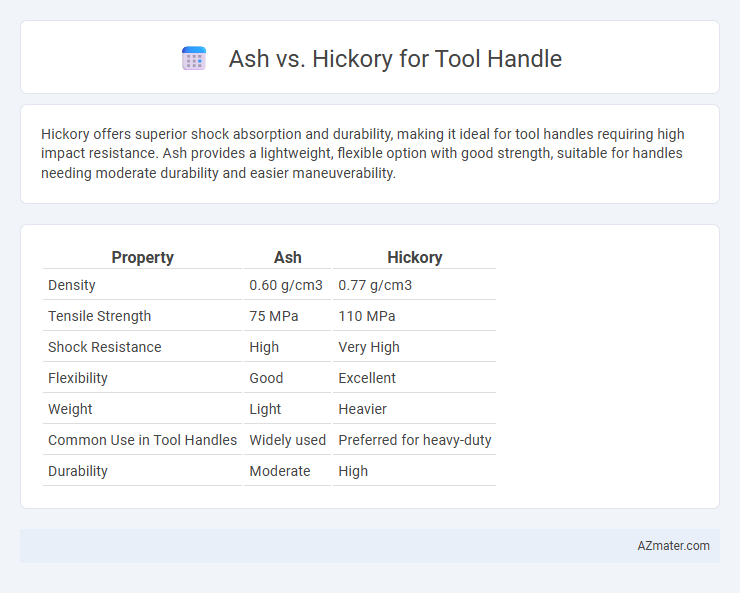Hickory offers superior shock absorption and durability, making it ideal for tool handles requiring high impact resistance. Ash provides a lightweight, flexible option with good strength, suitable for handles needing moderate durability and easier maneuverability.
Table of Comparison
| Property | Ash | Hickory |
|---|---|---|
| Density | 0.60 g/cm3 | 0.77 g/cm3 |
| Tensile Strength | 75 MPa | 110 MPa |
| Shock Resistance | High | Very High |
| Flexibility | Good | Excellent |
| Weight | Light | Heavier |
| Common Use in Tool Handles | Widely used | Preferred for heavy-duty |
| Durability | Moderate | High |
Introduction: Comparing Ash and Hickory for Tool Handles
Ash and hickory are two of the most popular woods used for tool handles due to their durability and shock absorption. Hickory offers superior strength and resilience, making it ideal for heavy-duty tools subject to intense impact, while ash provides a slightly lighter option with excellent flexibility and good shock resistance. Both woods feature straight grain patterns that enhance grip comfort and reduce the likelihood of splintering, ensuring reliable performance in demanding work environments.
Wood Density and Strength: Ash vs Hickory
Ash and hickory are both popular choices for tool handles due to their impressive strength and durability, with hickory boasting a higher wood density averaging around 830 kg/m3 compared to ash's approximately 680 kg/m3. This density difference makes hickory exceptionally shock-resistant and ideal for high-impact tools like hammers and axes. Ash, while slightly less dense, offers excellent flexibility and resilience, making it favorable for handles requiring both strength and some degree of shock absorption.
Shock Absorption Properties
Ash wood offers superior shock absorption properties compared to hickory, making it an ideal choice for tool handles that require vibration dampening. Its open grain structure allows it to flex under impact, reducing hand fatigue and improving control during prolonged use. Hickory, while durable and strong, is denser and transmits more shock, which can increase the risk of user discomfort over extended periods.
Durability and Longevity
Ash tool handles offer excellent shock absorption and moderate durability, making them suitable for general-purpose use, while hickory excels in strength and resilience, providing superior durability and longevity under heavy or repetitive stress. Hickory's dense grain structure resists wear and impact better than ash, resulting in a longer lifespan for tools subjected to rigorous use. Choosing hickory handles ensures enhanced performance and extended handle life, especially for demanding applications.
Workability and Ease of Shaping
Ash offers superior workability and ease of shaping due to its straight grain and elasticity, making it ideal for tool handles requiring shock absorption and durability. Hickory, while harder to shape because of its dense and interlocked grain, provides exceptional strength and impact resistance, suitable for heavy-duty tools. Both woods perform well, but ash is preferred for faster, cleaner shaping and ergonomic handle design.
Weight and Ergonomics
Ash provides a lightweight and shock-absorbent option for tool handles, enhancing user comfort during prolonged use. Hickory is denser and heavier, offering superior durability and impact resistance but can cause quicker fatigue. Ergonomically, ash allows for smoother grip and easier control, while hickory's sturdiness supports heavy-duty tasks requiring strength and stability.
Resistance to Splintering and Breakage
Ash is renowned for its exceptional resistance to splintering and breakage, making it a preferred material for tool handles that require durability and toughness. Hickory also provides strong resistance to impact and fracture, but Ash's fibrous grain pattern offers superior shock absorption, reducing the likelihood of splinters under high stress. The combination of strength and flexibility in Ash contributes to longer-lasting, safer handles in demanding work environments.
Cost and Availability
Ash tool handles offer a cost-effective option with widespread availability due to the tree's common presence in North American forests, making it a popular choice for budget-conscious buyers. Hickory handles tend to be more expensive because of the wood's superior toughness and shock resistance, yet they remain accessible through specialized woodworking suppliers and tool manufacturers. Both woods are valued for durability, but ash is typically preferred in large-scale production for its affordability and easier sourcing.
Common Applications and Industry Preferences
Ash tool handles are highly favored in woodworking and construction due to their exceptional shock absorption and lightweight properties, making them ideal for hammers, axes, and other striking tools. Hickory, renowned for its superior strength and resistance to wear, is preferred in heavy-duty applications such as pickaxes, sledgehammers, and sports equipment handles. Industries like carpentry and landscaping often choose ash for versatility and comfort, while forestry and mining sectors prioritize hickory for durability and longevity under intense use.
Conclusion: Choosing the Best Wood for Tool Handles
Ash offers excellent shock absorption and durability ideal for tool handles requiring flexibility, while hickory provides superior strength and resistance to impact, making it perfect for heavy-duty tools. Hickory's density and stiffness enhance longevity under repeated stress, whereas ash's lightweight nature improves user comfort during extended use. Selecting between ash and hickory depends on balancing the need for resilience versus strength in specific tool handle applications.

Infographic: Ash vs Hickory for Tool Handle
 azmater.com
azmater.com